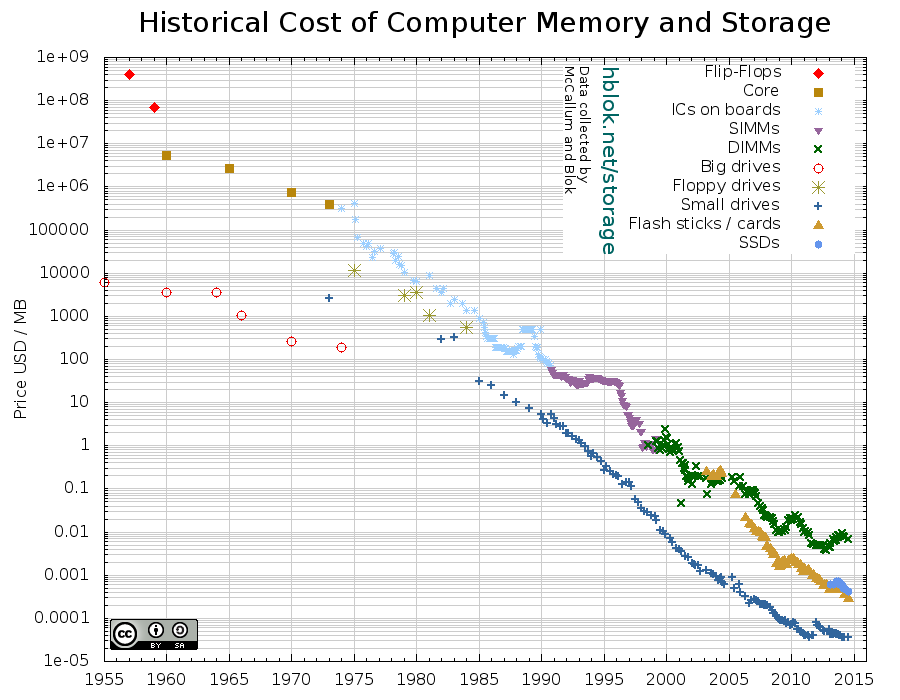Historical Cost of Computer Memory and Storage
I've finally gotten around to update the graph and data at hblok.net/storage. Since it has been a while since last time, I thought I would be left with a gap in the data. However, John C. McCallum who collected the original data got my back. I've incorporated his newer data points, as well as automated my own collection. Hopefully, it will not go quit so long between updates in the future.
RAM prices up
Due to a fire at the Hynix Fab plants in 2012, RAM prices are significantly up, and still at 2012 prices. Joel Hruska at extremetech.com has an interesting analysis into its effects. In the chart below, he notes that prices doubled after the fire. The latest data I've collected show that it's going in the right direction again. However, as Hruska also points out, the market for desktops is in decline, and laptops, tablets and phones will not need the same memory types.

HDD / Magnet disk prices go sideways
In 2011 flooding in Thailand caused major damage to HDD factories of Western Digital, Samsung, and Toshiba. Prices have almost recovered from that by now, however it means a set-back in the HDD trend by almost three years.
In another article by Joel Hruska, he includes the graph below from Backblaze who plotted real and estimated prices on different HDD types. Although he takes issue with Backblaze's extrapolation, it did get the significant lag of the trend right.
Furthermore, larger drives have yet to materialize. The 6 TB HGST (owned by Western Digital) Ultrastar He6 has been out for a while. Paul Alcorn at tweaktown.com discussed the details in a review a few months back. The trick is to put a whopping seven platters into the drive (as opposed to the normal three to five). However, to make that work, the drive has to be sealed and filled helium; thus its name. The new technology comes at a higher prices: It retails at Amazon for $476.99, or $0.0794/GB. That's more than double the Seagate 3TB at $109.99 or $0.0367/GB.
So although the helium technology has a long way to go, it could be the next step for higher capacity drives. At 6 TB over 7 platters, each hold only 857 GB. That is a bit off from the 1 TB platters which have been available for a long time now, and we were "promised" 1.25 TB platters by the end of this year. If the later are compatible with the "7Stac" technology, it could mean 1.25 * 7 = 8.75 TB drives in the future. If pricing also improves, it could be that the magnetic hard disk trend is back onto its 40 year track.

SSD and flash prices down
Flash memory and Solid State Drives have no accidents hampering their growth and price decline. The trend is linear (i.e. on the logarithmic scale) over the last ten years. Larger drives are also gradually becoming available, with SanDisk recently announcing their enterprise 4 TB Optimus MAX SAS, and predicting 8 TB SSDs by next year. In that Computer World article, they've included a Gartner graph, seen below, which predicts SSD price parity with HDD by 2017. It's important to note that they compare enterprise drives here, which live in a completely different world than the cheapest and biggest consumer drives.
For the chart I'm tracking, it is mostly the USB sticks that make it to the top, with the best price / capacity ratio. At this point, it seems that is not because the USB sticks are getting larger, but rather that the smallest ones are getting cheaper. SanDisk is now "giving away" 8 GB drives for less than $3 (although that does not give you free shipping at NewEgg).

Updated overall graph
Finally, the updated graph. The permanent link is hblok.net/storage

(Click for larger image)